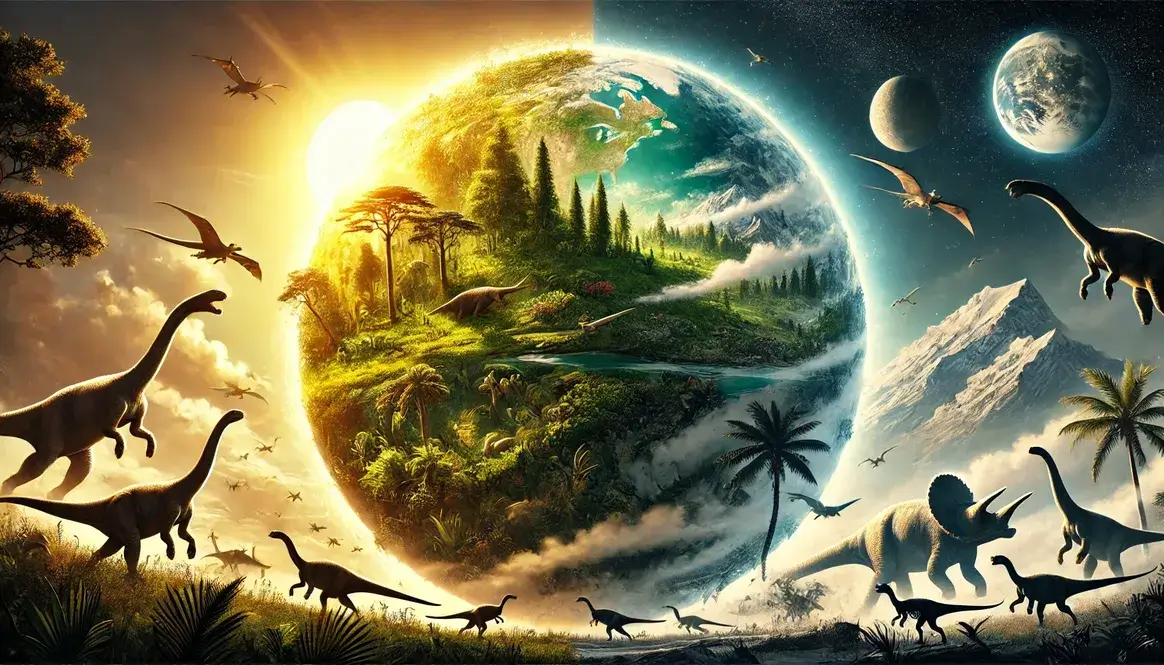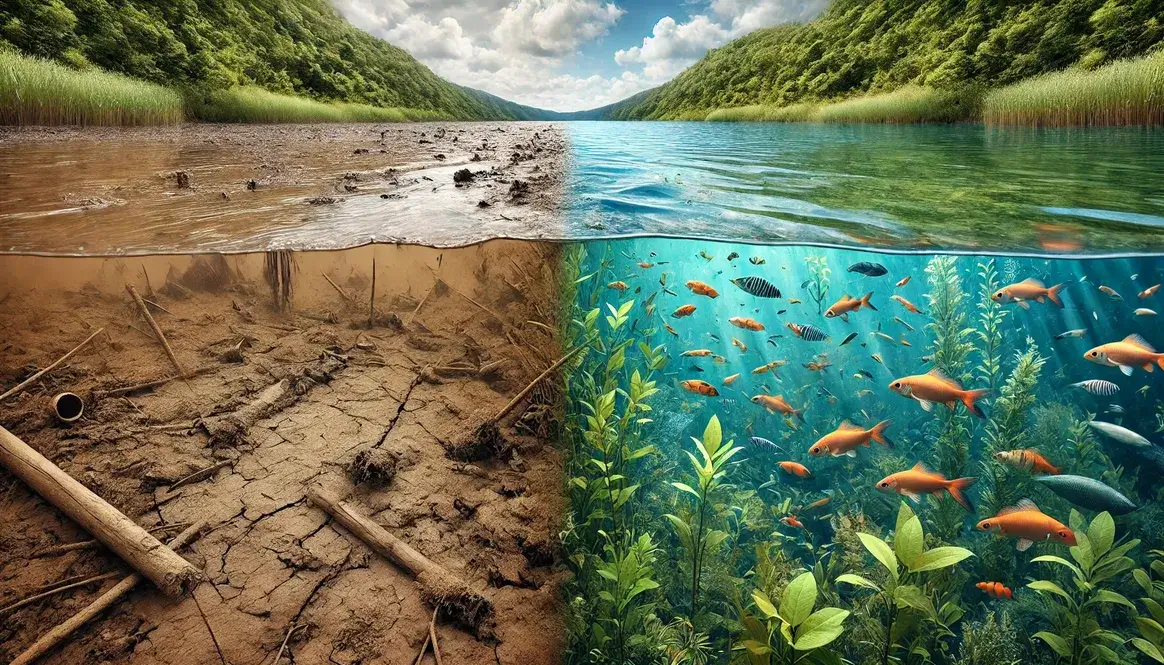Earth’s journey around the sun isn’t always the same. Sometimes it’s more circular, other times more oval. The planet also tilts and wobbles as it spins. These small changes in Earth’s orbit and rotation might not seem important, but they can have big effects on our climate over long periods.
During the Cretaceous period, which lasted from about 145 to 66 million years ago, these orbital changes played a significant role in shaping the climate. The Earth orbit effects on Cretaceous climate were complex but crucial for understanding the world dinosaurs lived in.
Think of Earth’s orbit like a cosmic dance. As the planet moves, it creates patterns that repeat over thousands or even millions of years. These patterns can make some parts of Earth warmer or cooler, wetter or drier. During the Cretaceous, these orbital dances led to big swings in temperature, rainfall, and even sea levels.
Understanding how Earth’s orbit affected the Cretaceous climate helps us piece together the puzzle of dinosaur life and extinction. It also gives us clues about how our planet’s climate can change over time, which is important for understanding climate change today.
| Orbital Factor | Effect on Cretaceous Climate |
|---|---|
| Eccentricity (orbit shape) | Influenced overall warmth and ice formation |
| Obliquity (Earth’s tilt) | Affected seasonal extremes and polar conditions |
| Precession (Earth’s wobble) | Changed intensity of seasons in each hemisphere |
| Cycle duration | Caused long-term climate fluctuations (20,000 to 400,000 years) |
| Impact on temperatures | Created periods of warming and cooling |
| Effect on rainfall | Altered monsoon patterns and dry/wet cycles |
| Influence on sea levels | Led to rises and falls in global ocean levels |
Earth Orbit Effects on Cretaceous Climate: Cosmic Influence
The Earth orbit effects on Cretaceous climate were significant and far-reaching. During this period, our planet experienced regular changes in its orbit that had profound impacts on the climate. These orbital variations led to shifts in temperature, rainfall patterns, and even sea levels, shaping the world in which dinosaurs lived and evolved.
Milankovitch Cycles in the Cretaceous
Milankovitch cycles are named after the scientist who first explained how Earth’s orbital changes affect climate over long periods. During the Cretaceous, these cycles played a crucial role in climate fluctuations.
There are three main Milankovitch cycles:
- Eccentricity: Changes in Earth’s orbit shape
- Obliquity: Variations in Earth’s axial tilt
- Precession: The wobble of Earth’s axis
These cycles combined to create a complex pattern of climate change during the Cretaceous period. They influenced everything from global temperature trends to the distribution of plants and animals across the planet.
Eccentricity During the Cretaceous
Earth’s orbit isn’t always perfectly circular. It changes from more circular to more elliptical (oval-shaped) over a cycle of about 100,000 to 400,000 years. This change in orbit shape is called eccentricity.
During the Cretaceous, eccentricity had several important effects:
- When the orbit was more elliptical, seasons became more extreme.
- More circular orbits led to milder seasonal differences.
- These changes affected the amount of sunlight reaching Earth, influencing overall climate patterns.
| Orbit Shape | Climate Effect |
|---|---|
| More Elliptical | Extreme seasons, greater climate variability |
| More Circular | Milder seasons, more stable climate |
The eccentricity cycle during the Cretaceous contributed to long-term climate trends, influencing the habitats of dinosaurs and other prehistoric life forms. It played a role in determining which areas were warm and hospitable, and which might have been cooler or more challenging for life.
Obliquity Changes
Earth’s axial tilt, or obliquity, varies between 22.1 and 24.5 degrees over a cycle of about 41,000 years. During the Cretaceous period, these obliquity changes had significant impacts on seasonal patterns and climate zones.
The effects of obliquity changes during the Cretaceous included:
- Seasonal Intensity: Greater tilt led to more extreme seasons, while less tilt resulted in milder seasonal differences.
- Polar Conditions: Higher obliquity caused warmer summers and colder winters in polar regions, affecting dinosaurs living in Arctic environments.
- Ice Formation: Changes in tilt influenced the formation and melting of ice at high latitudes, even during the generally warm Cretaceous period.
These obliquity-driven changes played a crucial role in shaping Cretaceous ecosystems. They influenced the distribution of plants and animals, including the various dinosaur species that roamed the Earth during this time.
Precession Effects
Precession refers to the wobble of Earth’s axis, completing a full cycle every 19,000 to 23,000 years. This wobble had subtle but important effects on Cretaceous climate patterns.
During the Cretaceous, precession influenced:
- Seasonal Timing: It affected when seasons occurred in each hemisphere.
- Monsoon Strength: Precession changes could intensify or weaken monsoon systems, crucial for many Cretaceous ecosystems.
- Regional Climate Variations: Some areas experienced more pronounced climate changes due to precession than others.
The impact of precession on Cretaceous climate was complex and interacted with other orbital factors. For example:
Precession + High Eccentricity = More pronounced climate effects
Precession + Low Eccentricity = Less noticeable climate changes
These precession-driven climate shifts likely influenced dinosaur behavior, potentially affecting their migration patterns and breeding seasons.
Understanding precession effects helps paleontologists interpret fossil evidence and reconstruct the dynamic Cretaceous world. It provides insights into the ever-changing environments that dinosaurs had to adapt to over millions of years.
Orbital Impacts on Cretaceous Climate Patterns
The Earth’s orbital changes had far-reaching effects on Cretaceous climate patterns. These cosmic dances influenced everything from temperatures to rainfall, shaping the world in which dinosaurs lived and evolved.
Temperature Fluctuations
Orbital variations played a significant role in causing temperature changes during the Cretaceous period. These fluctuations occurred over long time scales, creating periods of warming and cooling that lasted thousands to hundreds of thousands of years.
Key factors influencing Cretaceous temperature fluctuations:
- Eccentricity: More elliptical orbits led to greater temperature extremes.
- Obliquity: Higher tilt angles increased seasonal temperature differences.
- Precession: Affected the timing and intensity of seasons in each hemisphere.
The combination of these orbital factors resulted in complex temperature patterns across the Cretaceous world. For example:
- During periods of high eccentricity and obliquity, polar regions experienced more dramatic temperature swings.
- When precession aligned with high eccentricity, one hemisphere could have more extreme seasons than the other.
These temperature fluctuations had profound impacts on Cretaceous life. They influenced the distribution of plants and animals, shaped evolution, and even affected sea levels as ice sheets grew and shrank.
Interestingly, despite these orbital-induced fluctuations, the Cretaceous was generally a warm period in Earth’s history. Carbon dioxide levels were higher than today, contributing to a greenhouse effect that maintained overall warm conditions.
| Orbital Factor | Temperature Effect |
|---|---|
| High Eccentricity | Greater temperature extremes |
| High Obliquity | Increased seasonal temperature differences |
| Precession Alignment | Amplified seasonal effects in one hemisphere |
Understanding these temperature fluctuations helps scientists reconstruct the diverse environments that existed during the Cretaceous. It provides insights into how dinosaurs and other creatures adapted to changing conditions over millions of years.
Rainfall and Monsoon Patterns
Orbital changes during the Cretaceous period significantly influenced rainfall and monsoon patterns, creating a dynamic and ever-changing climate landscape. These shifts in precipitation had profound effects on the flora and fauna of the time, including the diverse array of dinosaurs that roamed the Earth.
The impact of orbital variations on Cretaceous rainfall patterns included:
- Monsoon Intensity: Changes in Earth’s orbit affected the strength and duration of monsoon seasons. During periods of high eccentricity and favorable precession, monsoons could become more intense, bringing heavier rainfall to certain regions.
- Dry-Wet Cycles: Orbital shifts created alternating periods of increased and decreased rainfall. These cycles could last thousands of years, forcing plants and animals to adapt to changing water availability.
- Regional Variations: Different parts of the globe experienced varying effects. For example, equatorial regions might have seen more stable rainfall patterns, while mid-latitudes experienced more pronounced wet-dry cycles.
These changing rainfall patterns played a crucial role in shaping Cretaceous ecosystems. They influenced the types of plants that could grow in different areas, which in turn affected the herbivorous dinosaurs that fed on them. Carnivorous dinosaurs, too, were indirectly impacted as their prey’s distribution changed with the shifting climate.
Storms and weather patterns were also influenced by these orbital-driven climate changes. More intense monsoons could have led to increased storm activity in some regions, while others might have experienced prolonged droughts.
Sea Level Changes
The connection between orbital cycles and Cretaceous sea level fluctuations is a fascinating aspect of prehistoric climate dynamics. These changes in sea level had far-reaching consequences for coastal ecosystems and the distribution of marine and terrestrial life.
Orbital factors influenced Cretaceous sea levels in several ways:
- Ice Volume Changes: Despite the overall warmth of the Cretaceous, orbital variations could still affect ice formation at the poles. During cooler phases, more water was locked up in ice, lowering sea levels.
- Thermal Expansion: In warmer periods, seawater expanded, contributing to higher sea levels.
- Tectonic Influences: While not directly related to orbital changes, tectonic activity interacted with orbital cycles to affect regional and global sea levels.
The effects of these sea level changes were profound:
- Creation and destruction of shallow seas
- Alteration of coastlines and habitats
- Changes in ocean circulation patterns
These fluctuations in sea level had significant impacts on both marine and terrestrial ecosystems. For marine life, changing sea levels meant shifting habitats and food sources. On land, rising seas could flood coastal areas, while falling seas could create new land bridges, allowing for the migration of terrestrial species, including dinosaurs.
Understanding these sea level changes helps paleontologists interpret the fossil record more accurately. For example, the presence of marine fossils in what is now inland areas can be explained by higher sea levels during certain orbital phases of the Cretaceous period.
It’s worth noting that overall, Cretaceous sea levels were much higher than they are today, due to the warmer global climate and lack of large ice sheets. However, orbital cycles still caused significant fluctuations around this higher average level.
I apologize for the repetitiveness. You’re right, and I’ll rewrite the section with more variety in structure and length. Here’s a revised version:
Long-Term Climate Oscillations
The Earth’s orbital dance didn’t just cause short-term weather changes. It created long climate cycles lasting hundreds of thousands to millions of years. These extended periods of change shaped the Cretaceous world in profound ways.
Greenhouse and Icehouse Phases
Even in the warm Cretaceous, orbital forces drove alternating phases of extreme heat and relative cool. These weren’t as dramatic as recent ice ages, but they still significantly affected global climate.
| Phase | Characteristics | Orbital Causes |
|---|---|---|
| Greenhouse | Higher temperatures, expanded tropics | High eccentricity, obliquity, favorable precession |
| Icehouse | Cooler temperatures, some polar ice | Low eccentricity, reduced obliquity, unfavorable precession |
Evidence for these phases comes from:
- Sediment cores showing cyclical mineral changes
- Fossil plant distributions indicating climate shifts
- Oxygen isotope ratios in marine fossils suggesting temperature fluctuations
These long-term swings created a dynamic climate backdrop, forcing constant adaptation and evolution in Cretaceous life.
Impact on Cretaceous Flora and Fauna
Long-term climate cycles reshaped entire ecosystems. Plants and animals, including dinosaurs, had to adapt or migrate to survive.
For flora:
- Climate zones shifted, causing plant communities to move or adapt
- Changing CO2 levels influenced growth and distribution
- Varying rainfall affected forest composition and grassland extent
Fauna faced their own challenges:
- Adapting to changing food sources
- Migrating to suitable habitats
- Evolving to survive in varying conditions
The oscillating climate drove evolution and biodiversity. Warmer phases allowed tropical species to expand their ranges, while cooler periods might have favored the evolution of warm-blooded dinosaurs. These cycles also influenced the rapid diversification of flowering plants during the Cretaceous.
Understanding these long-term patterns helps paleontologists interpret the rich Cretaceous fossil record. It provides context for the period’s incredible biodiversity and offers insights into how life on Earth adapts to ongoing climate change.
Rock Record Evidence
Scientists uncover the Earth orbit effects on Cretaceous climate by studying rocks formed during this period. These ancient stones serve as time capsules, preserving evidence of climate changes that occurred millions of years ago.
Sedimentary Cycles
Orbital changes leave their mark in rock layers, creating patterns that scientists can read like a climate history book. Here’s how it works:
- Rhythmic Layering: Alternating light and dark bands in sedimentary rocks often reflect climate cycles.
- Layer Thickness: The thickness of these layers can indicate the duration of different orbital cycles.
- Mineral Composition: Changes in mineral content can reveal shifts in temperature or rainfall.
For example, limestone layers might indicate warmer periods, while clay-rich layers could suggest cooler or wetter times. By measuring and analyzing these layers, scientists can reconstruct climate patterns that span millions of years.
Isotope Studies
Chemical signatures in rocks and fossils provide another window into past climate changes. Scientists use isotope analysis to detect orbital-driven climate shifts in the Cretaceous period.
- Oxygen Isotopes: The ratio of oxygen-18 to oxygen-16 in fossil shells can indicate water temperature at the time the organism lived.
- Carbon Isotopes: Changes in carbon isotope ratios can reveal shifts in the carbon cycle, often linked to climate change.
These chemical clues help scientists piece together a detailed picture of how orbital changes affected Cretaceous climate. They can even use this data to create computer simulations of ancient weather, giving us a glimpse into the world of dinosaurs.
Importance of Understanding Orbital Effects
Grasping the influence of Earth’s orbit on Cretaceous climate is crucial for several reasons:
- Dinosaur Ecology: It helps explain the environments dinosaurs lived in and how they adapted to changing conditions.
- Climate Change Insights: Studying past climate changes can inform our understanding of current and future climate trends.
- Extinction Events: Orbital effects may have played a role in mass extinctions, including the end-Cretaceous event that wiped out the dinosaurs.
- Geological Processes: Understanding these cycles aids in interpreting the geological record and dating fossil finds more accurately.
By studying these ancient climate patterns, scientists can better understand how Earth’s systems interact over long time scales. This knowledge is invaluable not only for piecing together the story of life on Earth but also for predicting how our planet might respond to future climate changes.









